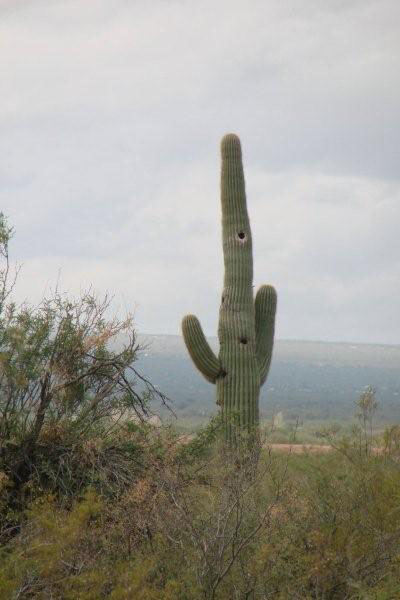
December 15, 2007

Driving toward the U.S. – Mexican border in the wee hours of the morning there is a cool breeze coming in through the window. We stop at an isolated convenience store on state highway 86 to get coffee, gum, and sunflower seeds for the road. The sun starts to come up and rapidly the (JPEG 1) heat of the day ahead bears down on us. The two-lane road winds, dips and rises through the Organ Pipe National Monument. Terrain densely populated with towering saguaro cactus, they block the rising sun in the distance and flash past resembling a strobe light. Taking in the scenery as we speed to our beach destination, abruptly the sight of a Border Patrol tower intrudes on the landscape. Several hundred yards beyond as we crest the next ridge our driver hits the brakes. We take in the sight of a group of people lined up along the side of the road surrounded by a multitude of Border Patrol agents and several vans and SUV’s parked in disarray on the pavement and in the ditch.
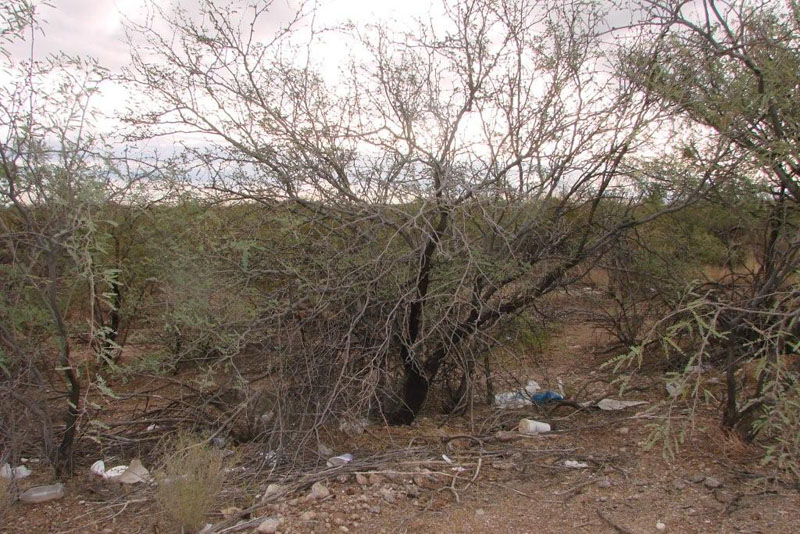
Immigration, whether authorized or unauthorized, has occurred throughout the world from the beginning of time and will most likely continue for all ages; a fact of life presently contributing to the deterioration of various desert life forms. Specifically, the southwestern Arizona desert lays claim to a great number of immigrants who cross the border illegally on foot or hidden in vehicles with a “coyote ” at the helm as they head north. Until recent years, one could travel into the desert to explore the extensive varieties of flora and fauna indigenous to the area without ever encountering another soul or any remnant signaling the proximity of a nearby civilization. On the whole, it has remained an untouched (JPEG 2) no-mans land. However, gradual indicators of illicit activity have emerged in areas considered to be corridors of illegal immigrant movement. Causing great concern for fragile ecosystems, the immense amount of debris left behind by veiled travelers evading capture is a huge detriment and comes at a high cost to the region
One wouldn’t consider a desert to be anything other than dry barren land that, in essence, is useless wasteland. Why would anyone care what happens to it? Yet, I can say with great pride that the Sonoran Desert is a distinctly beautiful place that exhibits great character. A region that, in fact, encompasses 120,000 square miles in southwestern Arizona, southeastern California, as well as most of Baja California and the western half of the state of Sonora, Mexico, it is a vast desert that consists of diverse ecosystems.
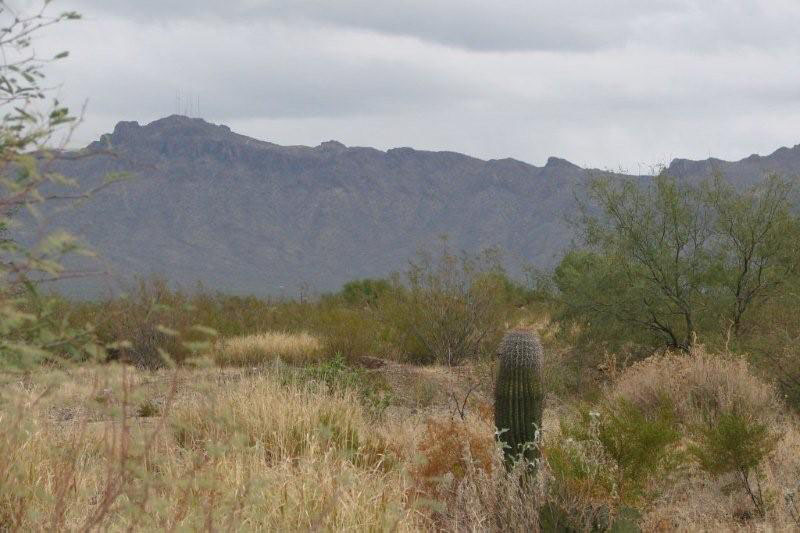
Nogales, Tucson, and Phoenix Arizona seem to be experiencing the brunt of illegal immigration. Encompassing around 2,000 species of plants, including the federally protected saguaro cactus which is primarily found in Southern Arizona; the Saguaro National Park is largely the area affected by the substantial number of unauthorized immigrants traveling on foot across this territory.
Unlike most deserts, the Southern Arizona desert receives heavy rainfall during the monsoon season; rainfall which causes normally dry-river beds to swell and surge over the banks. Although the rain is quickly absorbed by the parched, cracked earth as if it were a dry sponge, it provides incredible relief from the heat and almost magically enhances desert vistas. Immediately, one recognizes the power of life in the rain, not to mention the awesome displays of rainbows produced by the same.
Since the ringing-in of the new millennium, a forty percent increase in unauthorized immigration, particular to the southwestern border, has severely impacted the ecology, not to mention the economy in the region. Most notably, statistics show that over the past thirty years, illegal immigration has escalated from roughly 180,000 unauthorized entries per year in 1980 to about 850,000 per year since 2000 . The significant rise in illegal immigration in recent years has caused great controversy and contempt as the burden of medical and education assistance has taxed existing programs causing everyday citizens to take notice.
Contemplating and analyzing what has caused the shift since 2000, clearly there is increased desperation of many to make them wander the perils of the desert landscape. One must observe that their motivation to enter illegally is essentially two-fold. Acknowledging that no one human being should be barred from aspiring to excel in life, migrants are typically seekers of personal improvement. In that sense they should be congratulated. On the other hand, the United States has been touted as “the land of opportunity,” and notwithstanding immense legal barriers imposed for immigrants, for those too poor to pay and wait their turn it figures to be the best possible option. Certainly, deteriorating and brutal living conditions in third world countries are prime contributors to illegal immigration as well. Nevertheless, a large number of those making the ruthless journey have ulterior motives such as drug and people trafficking.
In retrospect, immigrants of the past have had similar visions as their inspiration to start anew in this land. Driven by devastating conditions in their homelands at the beginning of the twentieth century, impoverished immigrants who lacked much education arrived in droves from European countries to fill hard labor employment vacancies. Similarly, the pools of illegal immigrants presently arriving across the Mexican border are largely employed in hard labor type work due to their lack of education and proper work visas. On the whole, immigrants in the past demonstrated love and respect for their new surroundings. Concern for the environment and use of the land, to the extent that they recognized and reaped the benefits of the land, were integrated into daily life. Conversely, today’s immigrants crossing on foot demonstrate some disregard for the paths that bring them here.
Back in the days when it was acceptable to employ illegal immigrants for low paying, back-breaking jobs, they came by the multitudes. The era met illegal immigrants with jobs, company housing, albeit accommodations barely adequate for their large families; nevertheless, hardly any contempt. At once, they learned how to meld into their new world and, though they were inclined to seek out their own “people,” they learned to tolerate other races and ideals. Having experienced similarly corrupt governments, food and land troubles, illegal immigrants recognized the value of hard labor. In that aspect, life has not greatly changed.
In order to minimally understand the behaviors of those who enter illegally through the United States – Mexican border, it is important to get a glimpse of cultural attitudes. Since the majority of immigrants are from Latin America, poor, and have little to no education, they share many common ideologies. The way of life in Latin American countries differs considerably from life in the U.S. General populations must endure bureaucratic powers on almost every level of daily living. The lack of existing public programs, protection for the disadvantaged, or even the concept of customer services forces people to fend for themselves. People who, otherwise, have decent morals and values and work very hard to earn a living whilst trying to support a family learn of possibilities that may ease their burden. A large number of young men are willing to accept any job and frequently travel from town to town offering to work in the direst conditions for paltry wages. “Prices kept rising, and all families, mestizos and Indian, Mexican and illegal, Protestant, Catholic, or heathen, were able to afford less and less. Food was harder to come by: forget about telephones, clothes, cars, furniture. Even chicken feed, being maíz, was expensive. Pampers, milk, baby formula, shoes, tuition, tools, and medicine (Urrea, 2004, p. 44).” Illegal immigrants see only one way out.
Impervious to the obstacles in their way, illegal immigrants push forward in their journey to discovering the destination they heard so much about in the homeland. For most, it is a necessity to continue surviving that drives them to battle the elements of the harsh desert, for returning home is not an option. Desperation is the impetus that causes many to engage in unspeakable acts, legal or illegal, in order to risk obtaining a very distant and blurry dream. Sometimes alone, and sometimes with families, most illegal immigrants expose themselves not only to the unsympathetic terrain and weather, but also to the unscrupulous, ugly underworld. The underworld offers no allowances for impecuniosity, disability, gender, age, or family groups. Consequently, otherwise respectable people turn to drugs which are readily available among traveling criminal groups.
Indisputably, immigration without proper authorization is wrong regardless of mitigating circumstances. Even more reprehensible is the flagrant disposal of waste found indiscriminately strewn in many parts of the Arizona desert.
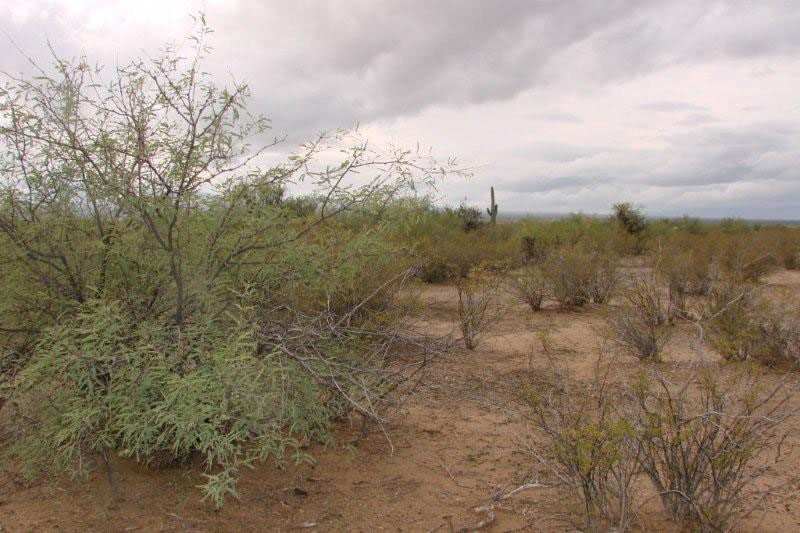
At a glance, the desert scenery in Southern Arizona is entrancing with its abundance of towering cactus, Joshua trees, flowering cactus varieties, colorful wildflowers, and rock formations. Upon closer inspection, the desert reveals the damage inflicted on it by careless passers-by. Of course, some litter can be attributed to reckless hikers or random visitors. Still, other types of environmental damage can be blamed on livestock or wild animals; however, the most striking evidence of damage is the scattering of leftovers concentrated in areas under mesquite trees, creosote bushes, or dry-river beds commonly referred to “lay-up areas.”
![]() The “nesting” that occurs in the desert under the cover of native plant life is similar to family groups of nesting apes in the jungle.
The “nesting” that occurs in the desert under the cover of native plant life is similar to family groups of nesting apes in the jungle. 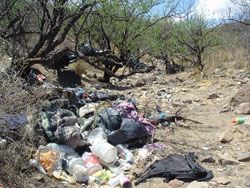 Undiscovered, the immigrants move on to the next area, as if guided by some sort of GPS system, they know exactly where to find respite. It is not uncommon for United States Border Patrols to encounter large groups of unauthorized immigrants gathered to rest, exchange information and stay out of sight. On the move like nomads, they leave behind what is no longer useful to them, or what has become too cumbersome to carry. What will it take to convey the negative effects of their negligence on the environment? Akin to other concessions made by our government, perhaps, it may be appropriate to install waste receptacles and translated notices regarding the consequences of littering in the desert.
Undiscovered, the immigrants move on to the next area, as if guided by some sort of GPS system, they know exactly where to find respite. It is not uncommon for United States Border Patrols to encounter large groups of unauthorized immigrants gathered to rest, exchange information and stay out of sight. On the move like nomads, they leave behind what is no longer useful to them, or what has become too cumbersome to carry. What will it take to convey the negative effects of their negligence on the environment? Akin to other concessions made by our government, perhaps, it may be appropriate to install waste receptacles and translated notices regarding the consequences of littering in the desert.
A long list of items, including abandoned vehicles, can be attributed to illegal immigrant groups traversing the desert. Items such as used needles, drug paraphernalia, plastic grocery bags, paper products, empty water containers, blankets, clothing, used disposable diapers, among other things. The heaps of litter long forgotten by those forging ahead come at a great cost to those who must bear the responsibility of cleaning it up. Sadly, the affects on the environment cannot, so easily, be repaired. Indeed, it is as much unnerving to acknowledge that such harm to our amazing desert ecology comes by such despair to survive. Hence, in killing the desert environment, illegal immigrants are finding life.
Much of the land that meets the official border is owned privately. Extensive parcels belong to ranchers who own immense herds of livestock. Accustomed to allowing their herds to roam freely, ranchers are abruptly finding the need to build and reinforce fences around their properties. One might think that fences are erected in such unforgiving remoteness in an effort to deter wild animals from invading and disturbing livestock, though surprisingly, one learns that the fences are in place to deter humans from entering and polluting the vast landscape, thus, harming livestock as well as wild animal life that dwell in the region.
Meanwhile, the Minutemen of Arizona are working hard to impede the traffic of illegal immigrants. As a corps of concerned citizens who have organized to be the eyes and ears of the government, they have taken steps to engage in securing the border, albeit with some questionable tactics. Where the government has demonstrated its shortcomings, the Minutemen have bridged the gap by providing their own funding to build and reinforce the border fences. Controversially, citizens have voiced concerns about the vigor with which the Minutemen operate. A sensitive subject to be sure, legal immigrants question the Minutemen’s authority to apply the law bearing arms. The volatile atmosphere in the region where piles of debris are often discovered signifying the continued trespassing of illegal immigrants is distressing to all on both sides of the border.
The United States Government is scrambling to find a suitable solution to the escalating problem while attempting to remain on good terms with foreign governments. Already the Mexican President has opposed the construction of a border fence that could potentially harm a delicate ecosystem in an area that straddles both countries.
Given that illegal immigration is a problem on many levels and that its effects are substantially bigger in some areas, it is imperative that the Arizona desert landscape not be overlooked. To see it may make one imagine an enormous garbage can spilled over from another country.
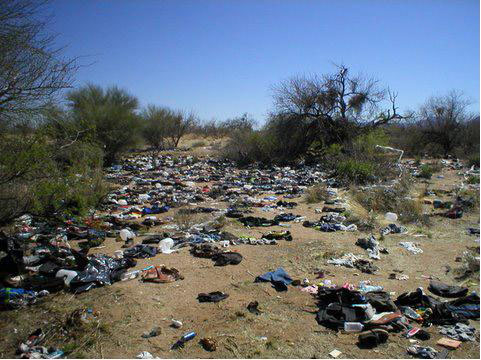
While there was a day when one could count on the peacefulness and beauty of the desert, that day appears to have come and gone. Alas, elementary school field trips to explore and learn about desert habitats in the real desert have been replaced by trips to museums. The exhilaration of a child encountering the true inhabitants of the desert such as roadrunners, scorpions, lizards and the like is almost as extinct as the freedom to cross the border without demonstrating every last piece of identification and, perhaps, leaving behind some form of collateral.
Illegal immigration into the U.S. through the Mexico border has, indeed, escalated significantly in the past twenty years causing increasing controversy and contempt. The “land of opportunity” appears to summon anyone desperate enough to take their chances. Nuvia Recinos and her family didn’t seem to have a choice and, although they made it from so far away alive, she still bears the emotional scars of the trek. In essence, obligation drives them; “what was it her kind always said – I love my country deeply and I am heartbroken at having to leave.” (Gordimer, 1974, p.71) They must do what they have to. Where is justice and who makes the rules? “Stripped of ethical rationalizations and philosophical pretensions, a crime is anything that a group in power chooses to prohibit (Freda Adler).” If they must leave their country through no fault of their own, but the miserable luck of being born where and how they were, it is only to reach for something that may or may not be there. They are inspired by hearsay and when there is nothing left, they embark on a journey toward a vision; never-mind that the boy leading the way is a con man. Why, the smuggler promises to take them to utopia.
Although it is riskier to lead large groups, the coyotes make more money and all too often make good on their promise to deliver their charges across the border into the Arizona desert. The illegals wonder how much further to utopia only to find out they’ve already crossed into it. The true journey has only just begun as they weave and backtrack without direction. “The dirt . . . gathered ahead or behind, rolling up its surface into a great charge of dust coming at them; . . .and then they were whipped into turmoil, it lashed round them a furry tongue of fiery soft dust spitting stinging chips of stone.” (Gordimer, 1974, p.86)
An immense challenge, the topography of the Arizona desert is as steep as it is flat and the day is as hot as the night is cold. Cadavers clearly tell their stories when they are found lying naked next to a pile of meticulously folded clothes. Unable to bear the weight or feel of the clothing on their backs, one expects to find the remains of haphazardly abandoned personal belongings somewhere along the path of staggered footprints. Nearly impossible for anyone to make it across the vast desert alive, illegal immigrants wind their way, confused and evermore focused on surviving, they begin to shed – first anything they have to hold onto, then anything they have strapped to their body. Over time, walking, resting, and walking again in the unbearable heat; no matter what time of day or night, things get heavier and heavier. Discarded items start to accumulate in marked “lay-up” areas.
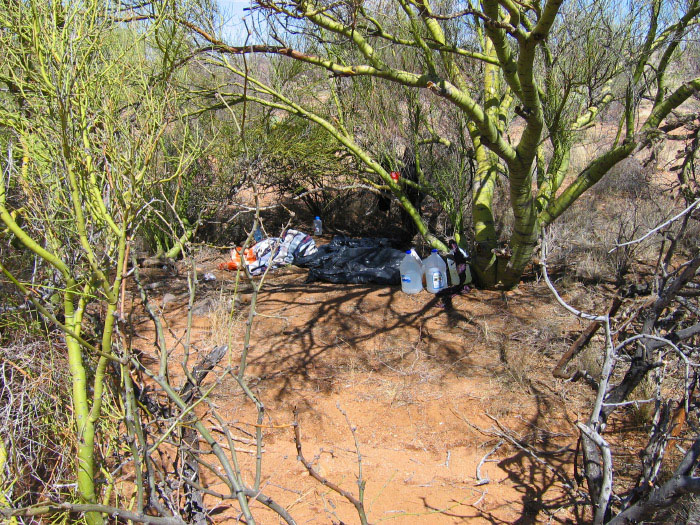
According to the Western Apache, “The land is always stalking people. The land makes people live right. The land looks after us. The land looks after people.” Among the Apache, short stories of people who suffered hardships such as illness and death in the wake of reckless behavior to the ecosystem are shared and passed down (Abrams, 1996, p.156).
Despite stereotypes (e.g. young people, p
oorly educated, poor self-image, disrespectful, lazy, careless, or dirty) of people who randomly dump garbage, research shows that there are other more prevalent factors, some of which may bear true with illegal immigrants. Taking into account the mental state of someone who has been walking in the desert for days without food or water, it is conceivable that the environmental effects of littering are not a concern. According to the Environmental Protection Agency, other, more common factors are: litter has already accumulated – the more litter present the more people are inclined to litter; lack of social pressure to do the right thing; absence of penalties or consistent enforcement; availability of receptacles; sense of pride or connection in the areas they are littering; or, the item is not considered litter such as cigarette butts. "Increasingly, the world around us looks as if we hated it (Alan Watts)."
On the other hand, those who clean-up after others are likely to have a positive attitude about life; they have knowledge and awareness about the environment; and, a sense of community and concern for others. Though, some people would like to make a statement by dumping garbage, this doesn’t appear to be the case with illegal immigrants. Environmental effects of littering in the desert are serious and include the indirect effect of water quality; death to livestock, wild animals, and plant life; blocked waterways and flooding; and, fire hazards among other things. The cost of clean-up to private land owners and local governments is staggering. A common theme that frequently arises during illegal immigrant interviews is that they have made the journey because they desperately wanted to fulfill their family’s dreams of owning their own home. However, "What's the use of a fine house if you haven't got a tolerable planet to put it on (Henry David Thoreau)?"
As in anything relevant to human beings, everyone has the answers, everyone takes their own side; hear it and everyone makes sense in their own twisted way. All the right answers abound, and yet hardly an attainable resolution exists. The government’s biggest and brightest minds are at work volleying ideas back and forth with no serious action taking place. Clearly, illegal immigration at the U.S. – Mexico border is the problem, but what do those two words imply? Try to dissect it and one begins to see the enormity of it. Like a bowl of Grape Nuts cereal, it keeps growing until one can no longer grasp the sheer size. It soon becomes evident that the “problem” is in fact many problems. When politicians address the problem, which part of it do they address? Is the state of the physical border the prevailing issue, the class and number of human beings entering, or the impact on the environment more pressing? Will resolving one, resolve the others?
Appearing as if the whole cause has been neglected for far too long, it has taken some serious breaches of homeland security to trigger awareness; however slight. Nevertheless, following the noise made by the Minutemen beginning in 2004, there were talks about reinforcing the border fence and augmenting Border Patrol forces. Though, it would seem a step forward in the right direction, due to budget constraints, it has not come to fruition. Until recently, pictures and stories of the, largely overlooked, Arizona desert environment have emerged. Parts of the desert are exhibiting incredibly blatant destruction. While the ecosystem would benefit, by default, from certain changes made to the physical border, it is imperative that the environmental impact of illegal immigration be addressed directly. According to the Devil’s Highway, “The Tohono O’Odham reservation began to see an astounding number of humans moving through their deserts. The Organ Pipe Cactus Nat’l Monument began to wither under two hundred thousand walkers passing through every year (Urrea, 2004).” If the federal government is not taking action as it relates to federal lands such as the Tohono O’Odham reservation, what can be expected for other largely affected regions?
The Minutemen Project makes a good point in calling citizens to action; “Ninety percent [of the solution] is driving this issue up the halls of Congress. It must come from the U.S. Senate, the House of Representatives, city mayors, city councils, state governors, grass roots tax-payers, up to Congress through our congressional representatives and that’s where it will be solved (J. Gilchrist, personal communication, November 7, 2007).” Notwithstanding the fallout that, typically, surfaces from rogue ideas such as those stemming from the Minutemen Project’s demand for citizen’s to guard the border, their organization exhibits sound fundamentals and pragmatism.
In the meantime, a more feasible, sound, and prompt solution relevant to the destruction of the environment would be to hold illegal immigrants responsible by requiring those who are captured and are slated for deportation to serve a minimum sentence of “litter duty” in the desert. In light of the fact that locals are burdened with the cost of desert clean-up, the cost would be significantly reduced by enlisting illegal immigrants to serve as laborers. Furthermore, fees normally paid for labor, would be put toward the cost of supplies and transportation, thus, alleviating the heavy burden to citizens, local governments, private companies, and above all the desert environment. Indeed, the impact of such a punishment for breaking the law would send a message to anyone planning on entering the country illegally; that deportation now comes at a price as did the entering with a coyote, thereby, causing illegal immigrants to intensely contemplate future attempts to enter without authorization. Moreover, this plan would appease legal citizens as well as local governments who, in general, bear the frustration of dealing with the same illegal immigrants entering the country time and time again, often within hours of being deported.
Some might argue that imposing a sentence on illegal aliens that requires them to serve on “desert trash duty,” would allow the deportee’s the opportunity to attempt an escape into the desert, consequently complicating matters. While many scenarios are possible in allowing illegal aliens “free roam,” to a limited extent, the program stands to be successful if it is thoroughly planned, supervised, and maintained. In addition, certain constituents could be opposed to spending public money on a program that, essentially, supports illegal aliens while they are in the country serving a sentence. Although providing shelter, food and uniforms to those serving would be a necessary part of the program, the grueling elements of the work to be done and the benefits to the desert ecosystem would more than outweigh the cost. On the other hand, the challenging clean-up work in the desert is already coming at a high cost to the government as they provide public employees to do the work of removing huge amounts of waste and abandoned vehicles.
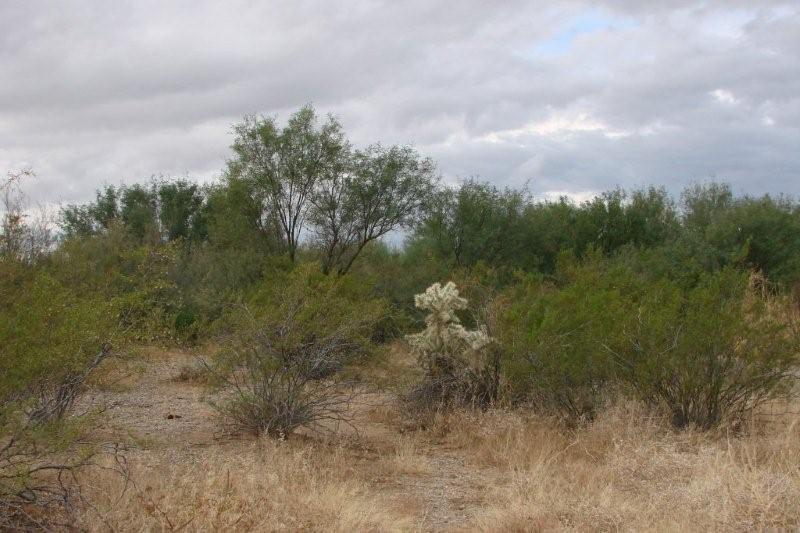
Obviously, a rather complex combination of issues as those described do not present a clear resolution at first glance. Nevertheless, approaching each matter separately can result in manageable parts which can be resolved individually and, perhaps, affect one another. Clearly, each issue is as grand as the next which will require a great deal of funding, manpower, direction, and commitment put forth by government officials, community organizations, and laypeople alike. Our deserts, like our rainforests, also deserve our attention – sooner rather than later.
References
Anastos, P., & French, C. (1991). Illegal: seeking the American dream. New York: Rizzoli.
Annerino, J. (1999). Dead in Their Tracks: Crossing America’s Desert Borderlands. New York, NY: Four Walls Eight Windows.
Beaumont, N. (1995) Beat the Border: An insider’s guide to how the U.S. Border works and how to beat it. Boulder, CO: Paladin Press.
Breslin, J. (2003). The Short Sweet Dream of Eduardo Gutierrez. New York, NY: Three Rivers Press.
Brown, P. G., & Shue, H. (1983). The Border that joins Mexican migrants and U.S. responsibility. Maryland studies in public philosophy. Totowa, N.J.: Rowman and Littlefield.
Chavez, P. (2007, April 6). Good to Be Brown and Think Green. La Prensa San Diego, p. 6. Retrieved September 18, 2007, from Ethnic NewsWatch (ENW) database. (Document ID: 1262744941).
Chomsky, A. (2007). "They take our jobs!" and 20 other myths about immigration. Boston, Mass: Beacon Press.
Conover, T. (1987). Coyotes: A Journey through the Secret World of America’s Illegal Aliens. New York, NY: Random House
Davis, T. (2005). Illegal Entrants’ Trash Woes Piling Up. The Arizona Daily Star (Tucson) Retrieved September 25, 2007, from http://usinfo.state.gov
Dernbach, J. C. (2002). Stumbling Toward Sustainability (p. 106) Environmental Law Institute.
Environmental Protection Agency (2007). http://www.environment.nsw.gov.au/litter/research.htm
Gans, J. (2007). Illegal Immigration to the United States: Causes and Policy Solutions. Udall Center for Studies in Public Policy. The University of Arizona <udallcenter.arizona.edu>
Gerdes, L. I. (2005). Immigration. Current controversies. San Diego, Calif: Greenhaven Press.
Gilchrist, J. Personal interview. 7 November 2007.
Gilchrist, J. & Corsi, J.R. (2006). Minutemen: The Battle to Secure America’s Borders. Los Angeles, CA: World Ahead Publishing
Gordimer, N. (1974). The Conservationist. London: Penguin Group
Graham, O. L. (2004). Unguarded gates: a history of America's immigration crisis. Lanham, Md: Rowman & Littlefield.
Hayworth, J. D., & Eule, J. (2006). Whatever it takes: illegal immigration, border security, and the war on terror. Washington, DC: Regnery Pub.
Herzog, L. (1997). The Transfrontier Metropolis: A new kind of international city. Harvard Design Magazine. Retrieved September 26, 2007, from http://mitpress.mit.edu/HDM
Lacy, M. (2006). Medical Missions Deliver Care: Pharmacy Students Make a Difference in Medical Mission Effort. The Borderline. Retrieved September 25, 2007, from http://www.houstonculture.org/border/healthpharm.html
Laufer, P. (2004). Wetback nation: the case for opening the Mexican-American border. Chicago: Ivan R. Dee.
Leinwand, D. (2006). Loose border saps county coffers. USA Today. Retrieved September 25, 2007, from http://www.usatoday.com/news/nation/2006-03-07-immigrants-health_x.htm
Nevins, J. (2002). Operation Gatekeeper: The Rise of the Illegal Alien and the Remaking of the U.S. – Mexico Boundary. New York, NY: Routledge
Newman, L. M. (2006). What rights should illegal immigrants have? Farmington Hills, MI: Greenhaven Press/Thomson Gale.
Payan, T. (2006). The three U.S.-Mexico border wars drugs, immigration, and Homeland Security. Westport, Conn: Praeger Security International.
Poynter, M. (1992). The Uncertain Journey: Stories of Illegal Aliens in El Norte. Ontario, Canada: MacMillan Publishing Company.
Province of Prince Edward Island, Canada. http://www.gov.pe.ca/enveng/litter/index.php3?number=61866&lang=E
Ramos, J., & Cordero, K. (2005). Dying to cross: the worst immigrant tragedy in American history. New York: Rayo.
Recinos, N. Personal interview. 2 November 2007.
Robbins, T. (2006). Environmentalists: Nature in Crossfire of Border War [Electronic version] National Public Radio
Sierra, Javier (2005, July 22). La Herencia Natural. El Sol de Texas, p. 8. Retrieved September 18, 2007, from Ethnic NewsWatch (ENW) database. (Document ID: 918466781).
Tancredo, T. (2004). Environmental Impact from Illegal Immigration. In Mortal Danger.
Terrez, J. V. (2005, May 22). Latinos and the environment. La Prensa,p. 4A. Retrieved September 18, 2007, from Ethnic NewsWatch (ENW) database. (Document ID: 876203191).
The Associated Press (2006). Illegals evicted from open-air church. San Diego, CA: Author. Retrieved September 24, 2007, from http://www.msn.com/id/16333528/
United States, & Clinton, B. (1994). Accepting the immigration challenge: the President's report on immigration. Washington, DC: [U.S. Office of the President].
Urrea, L.A. (2004). The Devil’s Highway: A True Story. New York, NY: Little, Brown and Company.
Vanderpool, T. (2006). Borderline Tragedy. The Tucson Weekly. Retrieved September 25, 2007, from http://www.tucsonweekly.com
Appendix A
Nuvia Recinos interview
Transcript taken November 2, 2007
“To hear a story told and retold in one’s childhood, and to recount that tale in turn when one has earned the right to do so (now inflected by the patterns of one’s own experience and the rhythms of one’s own voice), is to actively preserve the coherence of one’s culture (Abram, 1996, p.181).”
Nuvia Recinos, a petite woman with bright green eyes and lots of freckles, traveled with relatives from their home in El Salvador eluding the horrors of the civil war in that country. She described the details of what she could remember about that fateful journey, though it appears that she has mentally blocked much of what happened. During the interview Nuvia became rather upset, specifically when I asked her what she had been feeling during the long walk. Visibly disturbed by the feelings emerging, she continued to talk and stated that she kept thinking about her mother and wondered why things had happened so fast.
Interview: November 1, 2007
Name/Age: Nuvia Recinos/37 years old
Location: Restaurant for lunch
Conducted in Spanish & English
Questions:
Nuvia gave some indication that she had been sexually assaulted by a relative on the journey north and, again, became quite emotional. We wrapped-up the interview at that point. She stated that she would be willing to follow-up with me as she recalled other details.
Appendix B
Interview with Jim Gilchrist, Author and Founder of the Minutemen Project
Transcript taken November 7, 2007